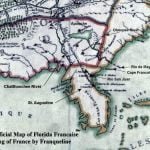
The Kingdom of France continued to claim the region between the Santee River in present day South Carolina and the St. Marys River in present day Georgia until the Treaty of Paris in 1763, when ceded all its territory in North America to Great Britain. Most European maps, except those of Great Britain labeled this “wannabe” province Florida Françoise. However, France did not officially participate in any further colonization efforts in the region after 1565. It is important to note that France never claimed the St. Johns River Basin and always on its official maps, labeled the Altamaha River as the May River.
King Henri IV of Navarre became the King of France in 1589. Navarre in the northern tip of Spain was a Protestant country. Henri was an important leader of the Protestant army in France. However, in order to bring peace to his country and secure the support of the Catholic majority, he converted back to Catholicism – at least nominally. There is no evidence that he ever changed his personal beliefs. After securing his throne, Henri issued the Edict of Nantes which gave religious freedom to all Christians. This brought peace to France. Henri became known as one of Frances greatest kings. The French prospered mightily under his reign. Henri IV was assassinated by a Catholic fanatic in 1610.
After the death of Henri IV, there followed a chain of Bourbon dynasty kings, who increasingly persecuted the Middle Class Huguenots. French Protestants began leaving France. The persecution reached a climax on October 22, 1685 when Louis XIV revoked the Edict of Nantes. All denominations of Christianity other than Roman Catholicism became illegal. Attending a Protestant worship service became tantamount to treason. The result was a middle class diaspora from France. Huguenots moved to England, Switzerland, Scotland, the Netherlands, the Protestant states of Germany and the Capetown Colony. This diaspora eventually resulted in France losing the race for supremacy with England and ultimately the extreme violence of the French Revolution.
The Colony of Carolina was ten years old when the Edict of Nantes was revoked. The boundaries of the southern division of this colony almost exactly matched those of Florida Françoise. The eight proprietors of the colony needed more settlers. French Huguenots were promised religious freedom and cheap land to migrate. Eventually, several thousand made the crossing of the Atlantic. They prospered in Florida Françoise and soon rose to leadership positions in the colony. Some of the most important leaders of the Patriots in South Carolina and Georgia during the American Revolution were French Huguenots.
Soon after the Colony of Georgia was settled in 1732, French Huguenots from South Carolina and Europe began settling there. Many of the other Georgia colonists were Scottish Presbyterians, whose beliefs were quite similar to those of the Huguenot Calvinists. Initially, there was no Huguenot church, so the Anglican Church in Georgia provided a French-speaking Anglican minister to hold services in French. Always a location that seem to attract the French, St. Marys drew both Huguenot and French Catholic immigrants throughout the 1700s and early 1800s. The French Revolution and Haiti’s War of Independence sparked major influxes of French refugees to South Carolina and Georgia.
Being fully accepted, if not admired, by their Anglo-American neighbors, the French Huguenots began spreading outward from their coastal enclaves in the early 1800s. By the 1850s descendants of French Huguenot refugees could be found throughout the Southeast. They quickly assimilated and intermarried into the Anglo-Celtic majority of the Southeast. Most joined denominations similar to their mother church. The French Protestant Church in Charleston, SC is the last remaining independent Huguenot church in the United States.
